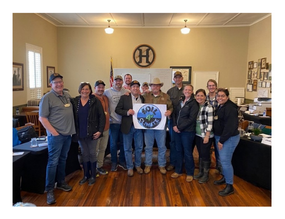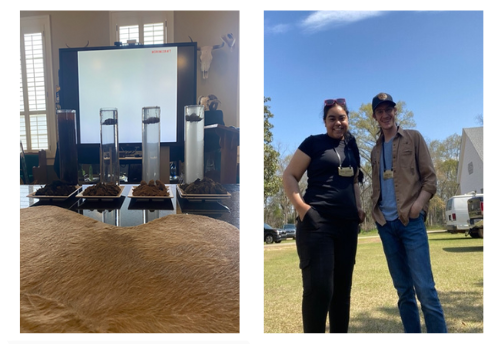“Anything you immediately notice?” Emily Gallagher plies us from the front of the room. “Texture? Smell? Color? Refrain from tasting, please!”
The warning from Gallagher, ecological services coordinator at White Oak Pastures, a regenerative farm in southwest Georgia, pulls a quick laugh out of the room. She’s asking about the soil she distributed to each of us. My portion rests comfortably in my hands, cool to the touch, deep brown, clean outdoors-y scent. It’s super pliable and has pieces of organic matter distributed throughout. Despite how healthy I know this soil is, I will be heeding Emily’s advice.
Gallagher’s found the quickest way to illustrate soil’s host of benefits to a room full of non-soil experts: getting our hands dirty.
Soil is key to managing operations at White Oak Pastures. Support for soil revitalization is increasingly acknowledged as a powerful way to mitigate greenhouse gas (GHG) emissions. This is evidenced with the work of the National Healthy Soils Policy Network and the litany of companies that are supporting regenerative farming through carbon credits.
Will Harris, White Oak Pasture’s fourth-generation owner, is a leading figure in the world of regenerative agriculture. He has a deep belief in the land and how it forms the foundation of community. On top of the open invitation to participate in the week-long Spring education program that is the Center for Agricultural Resilience (CFAR) of White Oak Pastures Harris urged us to meet our area farmers and buy locally.

Learning about and participating in your own food system can look like browsing the Common Market’s webpage for farmers. More hands-on methods include supporting stewards of the land at your local farmer’s market, and writing senators about pertinent soil policy. Placing more stock in small-scale farming is an admirable commitment to not just the planet, but one’s own health too.
Among the lectures, field excursions, and a very up-close and personal demo with White Oak Pasture’s soil, I came to understand the relationship between famers, soil, climate change, and me. As Harris says, “It ain’t just about measuring the damn carbon.”
Modern agriculture, while attributing 20% of global GHG emissions, is also the cause of deadly algal blooms off our coasts, hazardous pesticide use, and startling losses in essential nutrients and minerals in our food. The more holistic approach to farming that’s being undertaken at White Oak Pastures seeks to remedy many of these disastrous phenomena— starting with investing in soil health.
The USDA defines soil health “as the continued capacity of soil to function as a vital living ecosystem that sustains plants, animals, and humans.” It implies that there is some soil that does a better job of letting roots grow, of serving as a home for organisms, and of growing crops. Unhealthy, or dead soil, does a poor job with these vital actions that make earth survivable.
Historically, soil health hasn’t been at the forefront of modern agriculture’s goals. Modern agriculture’s main goal has always been increases in yield and efficiency of crop production. This was solved when the Haber-Bosch process, an artificial procedure to produce chemical fertilizer, was adopted in mass.
To be more specific, this process involves an artificial nitrogen fixation reaction to make ammonia, or nitrogen in its edible plant form. With the vital component nitrogen available for growing food, farm production exploded. Unfortunately, this arguably good invention was implemented at the expense of our soil.
After nearly a century and a half of chemical fertilizers, among other detrimental farming practices, overuse of these products leads to soil acidification (pH imbalance), infertility, lower rates of biodiversity, and paradoxically, lower crop yields. It turns that dark-brown, clean-smelling, speckled-with-organic-matter soil I mentioned earlier into the worst version of itself: a dull, lifeless, unsustainable dirt.

At White Oak Pastures, soil rehab involves biomimicry via multi-paddock grazing, a cutting edge and intuitive way to rotate and take advantage of each animal species being raised on the farm.
While keeping in mind natural abiotic factors, like erosion, water and carbon storage, and mineral retention, land stewards first recognize how each animal impacts the land.
For instance, poultry lower insect numbers and their excrement contains nitrogen. Hogs clear wooded areas and are advantageous for land historically used for pines, the most common tree used for logging in Georgia. Cattle, sheep, and other ruminants aerate and add moisture to the soil via deposition. Land stewards take the species to an area of the farm that needs a specific impact, and switch as needed.
The combination of abiotic and biotic factors work together to showcase biomimicry in its finest form. It’s a substantial task that the White Oak Pasture team handles with a dauntless level of spirit and skill.
For clarity, other factors like monocropping, deforestation, water erosion, and urbanization have contributed to the decline in soil health worldwide. The methods used at White Oak Pastures are only one part of the solution to revitalize barren soil. Overarchingly, the ideals of holistic management and biomimicry are key to the longevity of our planet.

Look how happy I am (right photo) thinking about soil! Also—Hi Jordan! (Right most person) Read Jordan’s blog about his time at CFAR here.